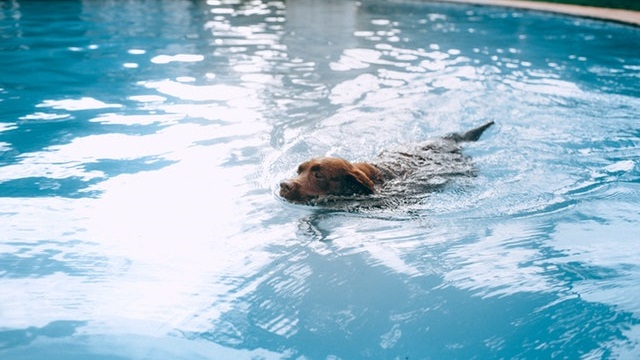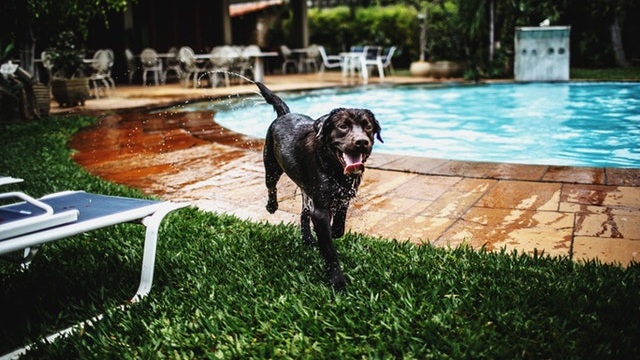Some dogs simply can’t stay away from water bodies. Maybe they need to cool themselves down on a hot summer day, or maybe they just adore splashing around. The point is, if your buddy likes to swim, you can rest assured they will make a dash for your swimming pool! ? That can be perfectly fine with you, but there are some hygiene concerns you should also take into account. So, check out the pros and cons of having dogs in swimming pools and pay particular attention to the safety tips!
Pro: swimming is a great workout

Swimming is a great workout for dogs of all ages. It’s low impact, it works the full body and it’s great to exercise the joints and limbs. It can even be used as a rehabilitation activity after an injury. ?
Safety tip: Warmer water is better for dogs. It lets them warm up faster and helps prevent cramps. Likewise, it allows for better blood flow and wider movements.
Con: hygiene

The dog will bring skin oils, hairs and possible parasites into the swimming pool, not to mention whatever dirt they have trapped in their coats. Besides, they don’t exactly clean themselves after a trip to the bathroom…
This means you and your family will be swimming and gulping water contaminated with fecal remains, bacteria, and general dirt. ?
Safety tip: Pump your swimming pool. Invest in a more efficient filtration system, consider installing faster water pumps to replace the water more often. Also, check the skimmer basket to see if it’s working properly and has the right piping and plumbing specifications. Test the water’s pH and chlorine levels more often, too.
Pro: it’s a great family activity
Watching dogs in swimming pools is always amusing! They seem to have a blast every time, even if they just float around and chill out.
It is also a great opportunity for the family to spend quality time with its furry member. Who doesn’t like to have fun playing games and laughing around between splashes?
For the dog, besides being a great exercise, it is also a way for them to relax, get rid of any stress and generally enjoy being a part of the family. ?️
Con: it can be dangerous

Some dogs are born swimmers, others can be trained to do it and then there are the ones who simply aren’t cut for it. ?
Short-nosed breeds are known to have a particularly hard time in swimming pools. It’s difficult for them to keep their muzzle out of the water, understandably. Small breeds can also struggle due to their small limbs, which means they’re bound to require more effort to move around.
Remember to always pay attention to your dog, even if they seem to be doing well, so you can act fast if you see any sign of struggle.
Safety tip: If you have any concerns that your dog might drown or at least struggle in a swimming pool, consider getting them a pet life jacket. This garment can also help good but short-nosed swimmers keep their muzzle out of the water and enjoy the exercise freely. You might also want to install a ramp (removable or not) in the swimming pool, so the dog can exit the water quicker and easier if they need to.
Pro: it’s refreshing

If you’re not sure how to keep your dog cool in summer, the pool might be the answer. Which explains why seeing dogs in swimming pools during the hottest season of the year is not that uncommon. ❄️
Safety tip: Make sure the water isn’t too cold or too hot, as the dog might go into shock due to the sudden temperature difference when they plunge in.
Con: chemicals
The chemicals in the water can be too harsh on the dog’s skin, leading to rashes, itchiness and flaking. Moreover, by weakening it, these chemicals can also create the perfect conditions for common dog skin diseases like yeast infections and dandruff. ?
Canines who swallow the water can also get an upset stomach due to these chemicals.
Safety tip: Always check the chemical levels of the water and ensure they are balanced. If your family and your dog keep getting rashes, dry skin and red eyes, the problem might not be in the chlorine itself. An imbalance between its contents, the water pH levels, its temperature and its hardness can be the cause.
If the dog gets their stomach upset by the water, you also need to readjust the chlorine content.
Having dogs in swimming pools has its pros and cons. The most important thing to consider is safety, which includes hygiene. A deficient maintenance and cleaning of the pool can turn a fun afternoon with the family into a visit to the hospital, due to bacterial or viral infections your dog inadvertently brought into the water. As long as you keep safety and cleaning a priority, though, everything should be fine – and you can enjoy splashing around with your buddy. ?






